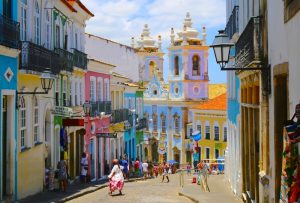By Lindenberg Junior / English Edition: Ann Fain
 It’s right there, on the “Pelô” that people from Bahia and tourists both meet. Where visitors surrender themselves to hair braids, and Olodum warms up their drums, where the “Filhos de Gandhi” (the Sons of Gandhi”) and Ilê Ayê carnival blocks give their first steps during carnival. Where boys and girls play the capoeira and where good local pottery can be bought. The Pelourinho Ladder and some of its adjacent streets are paved with “cabeça-de-negro” stones (literally “head of a black person”), a remembrance of Brazilian history.
It’s right there, on the “Pelô” that people from Bahia and tourists both meet. Where visitors surrender themselves to hair braids, and Olodum warms up their drums, where the “Filhos de Gandhi” (the Sons of Gandhi”) and Ilê Ayê carnival blocks give their first steps during carnival. Where boys and girls play the capoeira and where good local pottery can be bought. The Pelourinho Ladder and some of its adjacent streets are paved with “cabeça-de-negro” stones (literally “head of a black person”), a remembrance of Brazilian history.
Located in the Pelourinho are the “Fundação Casa de Jorge Amado” (Jorge Amado’s house Foundation”), the Benin House and the Old Medical School. The school now houses the Afro-Brazilian Museum, with various objects ranging from African cults to the Orixás, and the Archeology and Ethnology Museum, with different artifacts found at archeological sites. Considered by UNESCO a patrimonial for mankind since 1985, the most important place of Salvador, the Pelô also spreads art around the state of Bahia.
The streets covered with stones, small houses and ancient churches of the Pelourinho, tell the story of Bahia and its people. Old buildings, monuments and celebrations are all expressions of the history, art and culture of the most influential Afro-Brazilian city in Brazil: Salvador. With a range of architectural constructions that include more than 800 lofts, manors, small palaces, churches and convents, the Pelourinho exhibits the true identity of Bahia, which might be why it is the most visited location in the city of Salvador by Brazilian and foreign tourists alike.
During the XVII century the richest rural proprietors began to own very sumptuous houses at the Centro Histórico![]() (Historical Center). The number of churches increased and from the ninetieth century onward, commerce started to control the area. The so-called noble families moved to other parts of the city, leaving behind buildings that were turned into brothels. Until 1994 the Pelô neighborhood wasn’t a recommended place to go, but the restoration that began about this time gave the potential for tourism and added a new cultural dimension to the area.
(Historical Center). The number of churches increased and from the ninetieth century onward, commerce started to control the area. The so-called noble families moved to other parts of the city, leaving behind buildings that were turned into brothels. Until 1994 the Pelô neighborhood wasn’t a recommended place to go, but the restoration that began about this time gave the potential for tourism and added a new cultural dimension to the area.
Dance “this” and dance “that”, dance “na boca da garrafa” (the bottle dance) or dance “no cabelinho” (the hairdo dance), every year people from Bahia enjoy new choreographies that come straight out of the most humble neighborhoods to sometimes gain worldwide attention. The sounds of Bahian drums are a constant throughout the year and the excitement of the drummers and the frenzy of the dances dictate the way the body moves. Pelô equals animation, culture and happiness. Besides the traditional Axé music, there’s also room for salsa and nice jazz.
Leaving the historical center of the city and moving towards the Associação Atlética da Bahia, you’ll find Margareth Menezes working the crowd with her concerts or you can listen to Araketu rehearsing at the Aeroclube. That’s the way of the Pelourinho and the places that surround it, full of happiness, good vibes, music, sounds of the berimbau, capoeira, pottery, safety, excited tourists and, especially, history and tradition. Axé!

